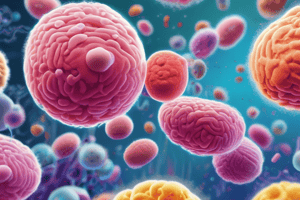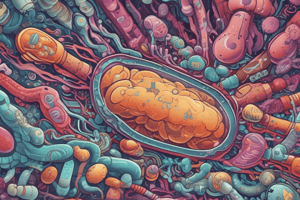Podcast
Questions and Answers
What is the primary function of antibiotics?
What is the primary function of antibiotics?
- To treat viral infections
- To inhibit protein synthesis in human cells
- To destroy or slow the growth of microorganisms (correct)
- To strengthen the human immune system
Which type of antibiotic is effective against a wide range of bacteria?
Which type of antibiotic is effective against a wide range of bacteria?
- Bactericidal antibiotic
- Narrow-spectrum antibiotic
- Bacteriostatic antibiotic
- Broad-spectrum antibiotic (correct)
How do antibiotics like penicillin work?
How do antibiotics like penicillin work?
- By strengthening the human immune system
- By interfering with bacterial cell wall synthesis (correct)
- By inhibiting DNA replication
- By inhibiting protein synthesis
What is the main cause of antibiotic resistance?
What is the main cause of antibiotic resistance?
What is the consequence of antibiotic resistance?
What is the consequence of antibiotic resistance?
What type of antibiotic inhibits bacterial growth, but does not kill bacteria directly?
What type of antibiotic inhibits bacterial growth, but does not kill bacteria directly?
Flashcards are hidden until you start studying
Study Notes
What are Antibiotics?
- Antibiotics are medications that destroy or slow the growth of microorganisms, such as bacteria, fungi, and protozoa.
- They are used to treat bacterial infections, not viral infections.
Types of Antibiotics
- Bactericidal: Kill bacteria directly (e.g., penicillin, ampicillin).
- Bacteriostatic: Inhibit bacterial growth, but do not kill bacteria directly (e.g., tetracycline, erythromycin).
- Broad-spectrum: Effective against a wide range of bacteria (e.g., amoxicillin, ciprofloxacin).
- Narrow-spectrum: Effective against a specific type of bacteria (e.g., vancomycin, metronidazole).
Mechanisms of Action
- Inhibit cell wall formation: Interfere with bacterial cell wall synthesis, causing the cell to weaken and eventually die (e.g., penicillin).
- Inhibit protein synthesis: Interfere with bacterial protein synthesis, necessary for cell growth and reproduction (e.g., tetracycline).
- Inhibit DNA replication: Interfere with bacterial DNA replication, necessary for cell growth and reproduction (e.g., ciprofloxacin).
Antibiotic Resistance
- Definition: The ability of bacteria to resist the effects of antibiotics.
- Causes:
- Overuse and misuse of antibiotics.
- Genetic mutation and adaptation of bacteria.
- Inadequate infection control practices.
- Consequences: Reduced effectiveness of antibiotics, increased risk of treatment failure, and increased risk of antibiotic-resistant infections.
Side Effects and Interactions
- Common side effects: Nausea, diarrhea, allergic reactions, and yeast infections.
- Interactions: May interact with other medications, such as blood thinners, and may affect the efficacy of birth control pills.
Antibiotic Use and Stewardship
- Appropriate use: Only use antibiotics when necessary, and choose the appropriate antibiotic based on the type of infection.
- Antibiotic stewardship: A coordinated effort to promote the responsible use of antibiotics, reduce antibiotic resistance, and improve patient outcomes.
Studying That Suits You
Use AI to generate personalized quizzes and flashcards to suit your learning preferences.




